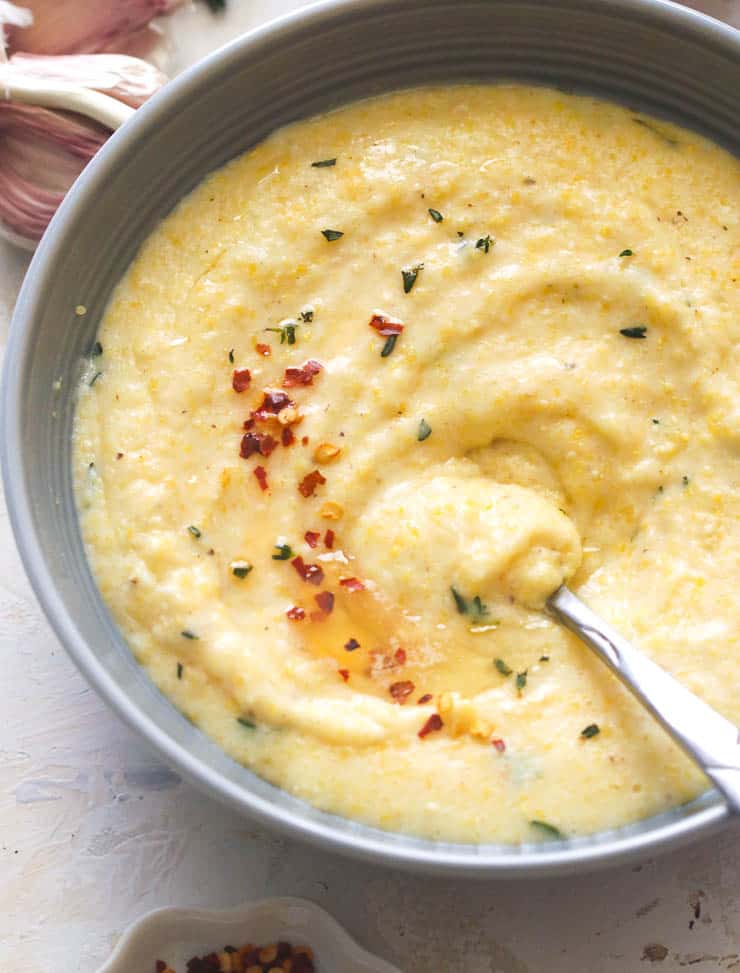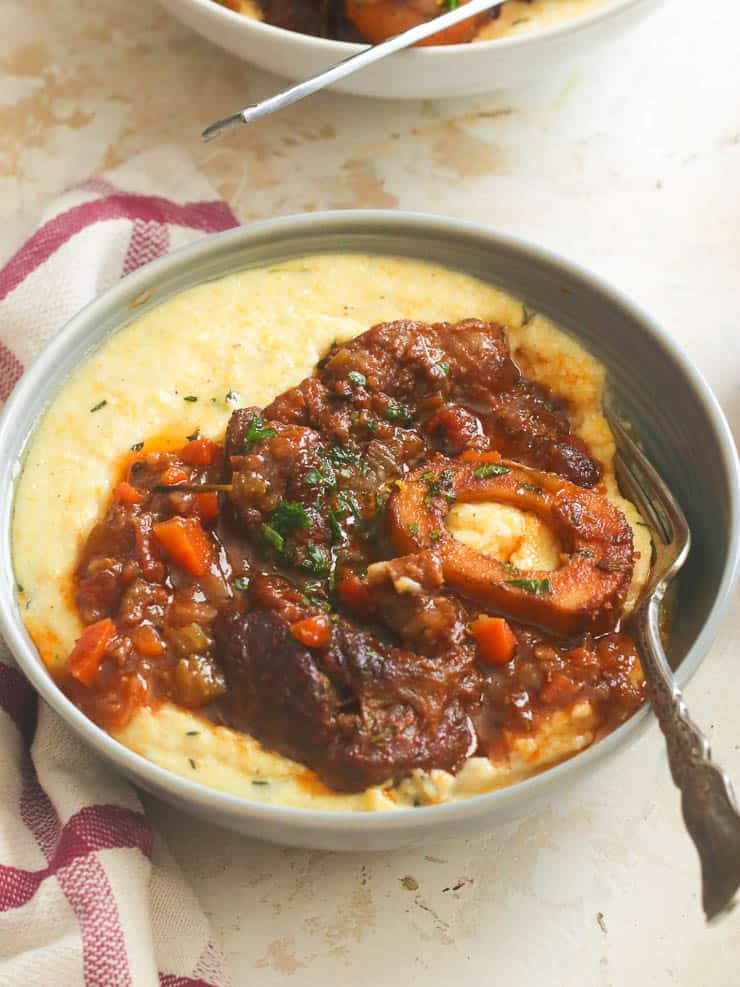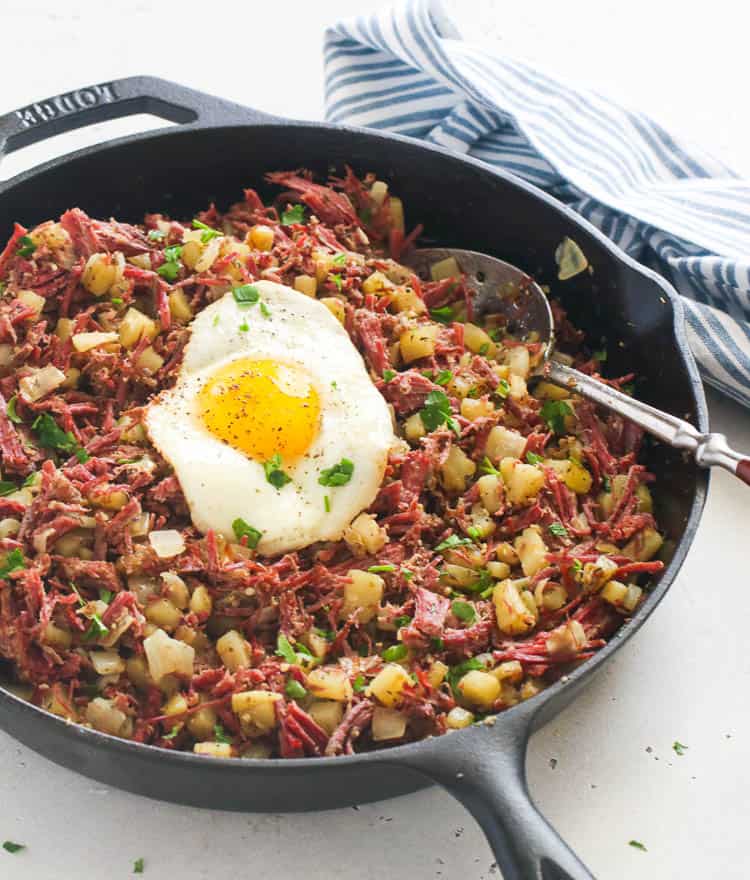Creamy Polenta
Fuss-free, smooth, cheesy, and creamy POLENTA made with cornmeal, cheeses, milk, and chicken stock. It makes a luscious bed for sautéed vegetables or braised pork, chicken, lamb, beef, or veal. The ultimate Italian comfort food that spells restaurant-quality. Great for regular nights or special holidays!
Happy hump day! For those who missed our Monday’s scrumptious Osso Buccobraised veal shanks), now is the time to make it along with its classic pair Polenta.
And in case you haven’t noticed yet, this week’s food theme is bringing you to the birthplace of pizza and lasagna – Italy. If last week was all about the vibrant Mexican cuisine just in time for the Cinco de Mayo celebration, this week I’m bringing you to this lovely European country Italy.
What is Polenta?
Polenta is an Italian porridge that uses coarsely ground cornmeal. If the Southern has grits, then the Italians have their very own Polenta. It’s usually paired with meat dishes like Osso Bucco, Ragu, and all other Italian food. Aside from serving it as a hot creamy porridge, you can also let it cool, solidify, and serve as bread.
Cornmeal vs Polenta
These two tend to be used interchangeably but Polenta is actually a dish and not an ingredient. If you see labels on boxes that say “Polenta”, it basically means that the texture of the ground corn is appropriate to make as a polenta dish.
But you can always swap it with regular medium or coarsely ground cornmeal. Just stay away from finely ground cornmeal or corn flour as they have finer consistency that would result in more like a pasty texture.
Polenta vs Grits
Both grits and polenta are made from dried ground corn. But they do differ in the type of corn used and the number of times it has been ground. The Southern staple grits is traditionally made from dent corn, whereas polenta is from flint corn. In comparison, grits is somewhat mushy and smoother compared to the toothsome and coarse texture of polenta.
Creamy Polenta Ingredients
If you’ve grown up waking up to cornmeal porridge, then this polenta is just right up your alley. It uses just a handful of pantry-friendly ingredients.
- Butter
- Garlic
- Thyme
- Chicken stock or water
- Bay leaf
- Whole milk
- Salt
- Coarse cornmeal
- Parmesan and gouda cheeses
- Pepper flakes (optional)
Recipe Variations
You can make this dish as basic as possible actually. But if you have the opportunity to make it pretty much interesting, then please feel free to do so. After all, this creamy dish is super versatile.
- Ran out of chicken stock? Don’t worry, you can swap it with plain water as the liquid for this recipe.
- If you think more herbs would make this dish more inviting, I’d suggest you go for a little dried parsley or fresh chopped parsley, thyme, oregano, chives, or sage.
- Other than parmesan and gouda cheeses, you can also use sharp white cheddar cheese, ricotta, mozzarella, mascarpone, or goat cheese.
- Want some protein in it? You can throw in some cooked shrimp or chopped bacon and ham.
- For leftovers, transfer it to a loaf pan and leave it in the fridge to solidify overnight. The next day, you can slice and grill or toast them on the stovetop for breakfast.
How to Make Ahead and Reheat
To make this creamy polenta recipe ahead of time, prepare it as per directions below then let it cool. Cover it and place it in the fridge for up to 2 days.
When ready to serve, reheat the polenta on the stovetop or in the microwave for about 5 minutes. To make it somewhat creamy again, stir in a little liquid like broth, water or milk and stir until you’ve reached your desired consistency. Add more liquid, if desired. And serve hot. Yum yum!
What to Serve with Polenta
Aside from pairing this with my Monday’s braised meat recipe Osso Bucco, you can also serve this with gremolata (included in the recipe box) or any of the following below:
- Some roasted broccoli florets, Brussel sprouts or cauliflower
- Breakfast eggs
- Italian sausages or any meat, in general, be it braised, grilled or fried
- Sautéed mushrooms or spinach
Got some more ideas on what to pair with these? I’d love to hear them.
More Italian Dishes to Explore
How To Make Creamy Polenta
Melt 2 tablespoons of butter in a medium saucepan, over medium heat, then add garlic and thyme. Stir for about 30 seconds or until fragrant. Do not let it burn. Pour in stock or water, bay leaf, milk, and salt. Bring to a boil. As soon as it boils, slowly add the polenta in a steady stream, whisking constantly to prevent any lumps. Reduce the heat to low and cover. Stir vigorously every 10 minutes or so, be sure to scrape the sides, bottom, and corners of the saucepan as you stir. Cook polenta thickens and is very tender and creamy, about 25. Cook an extra 5 minutes, for extra creamy. Add cheeses and remaining butter, stir well. Adjust seasoning to taste. Remove from heat and transfer to serving plates or bowl garnished with grated cheese, butter, and/or pepper flakes. Serve hot.
Watch How To Make It
[adthrive-in-post-video-player video-id=”uRh0YVHn” upload-date=”2020-12-03T08:14:08.000Z” name=”Creamy Polenta” description=”Fuss-free, smooth, cheesy, and creamy POLENTA made with cornmeal, cheeses, milk, and chicken stock. It makes a luscious bed for sautéed vegetables or braised pork, chicken, lamb, beef, or veal. The ultimate Italian comfort food that spells restaurant-quality. Great for regular nights or special holidays! ” player-type=”collapse” override-embed=”false”]

















Hi! I only have fine cornmeal on hand…any recommendations on adjustments? Looking forward to making this!
Hi liz!
you can certainly use it as a substitute for the coarser variety typically used in polenta. Fine cornmeal will cook faster and result in a smoother texture. Here are a few tips for making adjustments:
Watch the Cooking Time: Fine cornmeal will cook more quickly than coarse cornmeal. Keep an eye on it and be ready to reduce the cooking time.
Stir Frequently: Fine cornmeal tends to clump more easily, so stir the polenta frequently to prevent lumps from forming.
Adjust Liquid Quantities: You might need slightly less liquid since fine cornmeal absorbs water more quickly. Start with the recipe’s recommended amount, but be prepared to add a little less.
Taste and Texture: The final texture will be smoother than traditional polenta. If you prefer a thicker consistency, cook it a bit longer to evaporate more liquid.
Seasoning: Since the texture and flavor might be slightly different, taste and adjust the seasoning as needed.
Enjoy making your polenta, and I hope it turns out deliciously creamy!
Pretty good!
Thank you Richard:)
This recipe looks great. Do you think I could mix in Burrata instead of the other cheeses you listed? I like the rich creamy ness of Burrata better than other cheeses.
Yes you sure can. Thanks
Regular milk ? Or can you use carnation milk or heavy whipping cream ?
Hi Sage. Either of them will work just fine. Adjust the thickness with water or more broth. Do let me know how it turns out for you :).
Made this last night. My husband took a bite, looked at me and said, “This is so much better than that other dish you make.” I knew he was referring to the grits recipe I use. Imma, I have to look up your grits recipe!
He’s right, this is very good. And I agree, restaurant quality. I used ricotta and parmesan and served it with lamb chops. Thanks, Imma!
Awesome!! I am so glad this was a hit with you and your husband too :)! I will just go ahead and attach the my grits recipe here 🙂
Regular grits https://www.africanbites.com/grits-recipe/
Cheese grits https://www.africanbites.com/cheese-grits/
Cajun Shrimp grits https://www.africanbites.com/cajun-shrimp-grits/
Enjoy!!
Can you use 1% milk?
I make polenta regularly but thanks to you from now on I will be able to make an improved version of it. Thank you!
Can you use vegetable stock
Yes you sure can.
Funny, I’m planning on having some tomorrow ! 😀